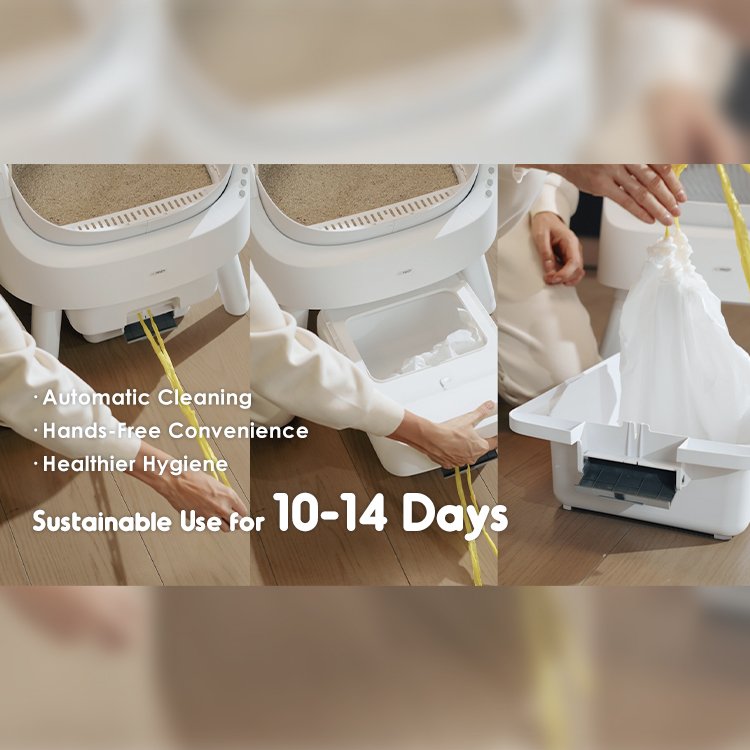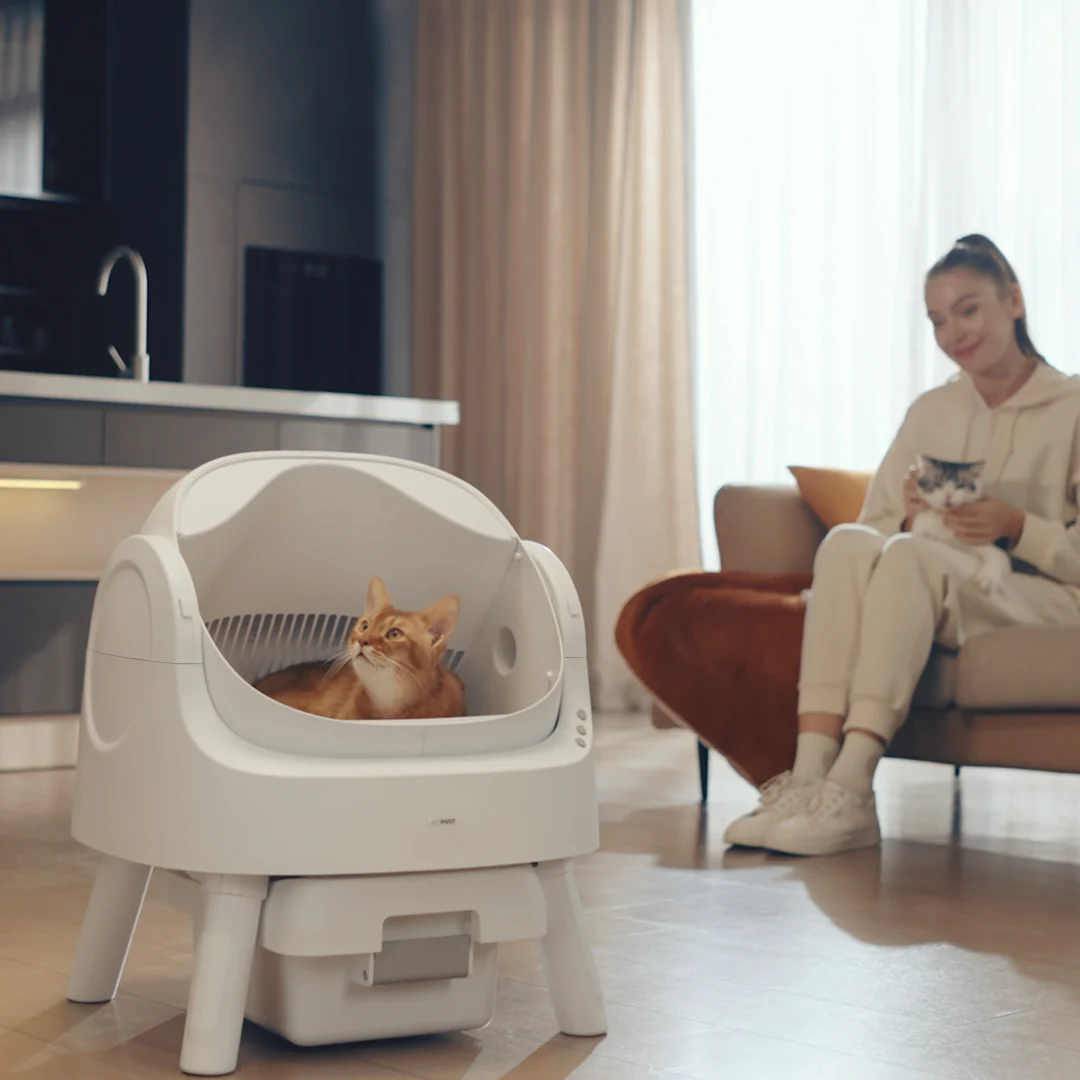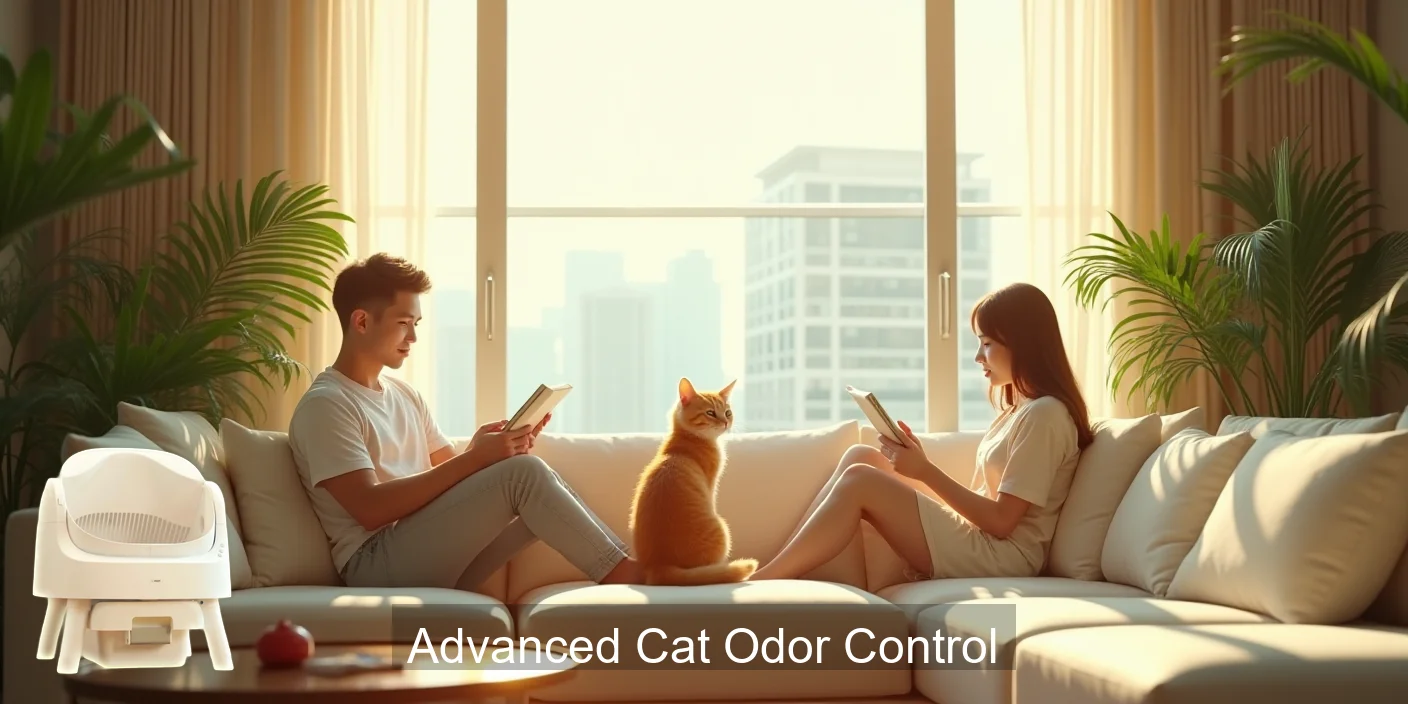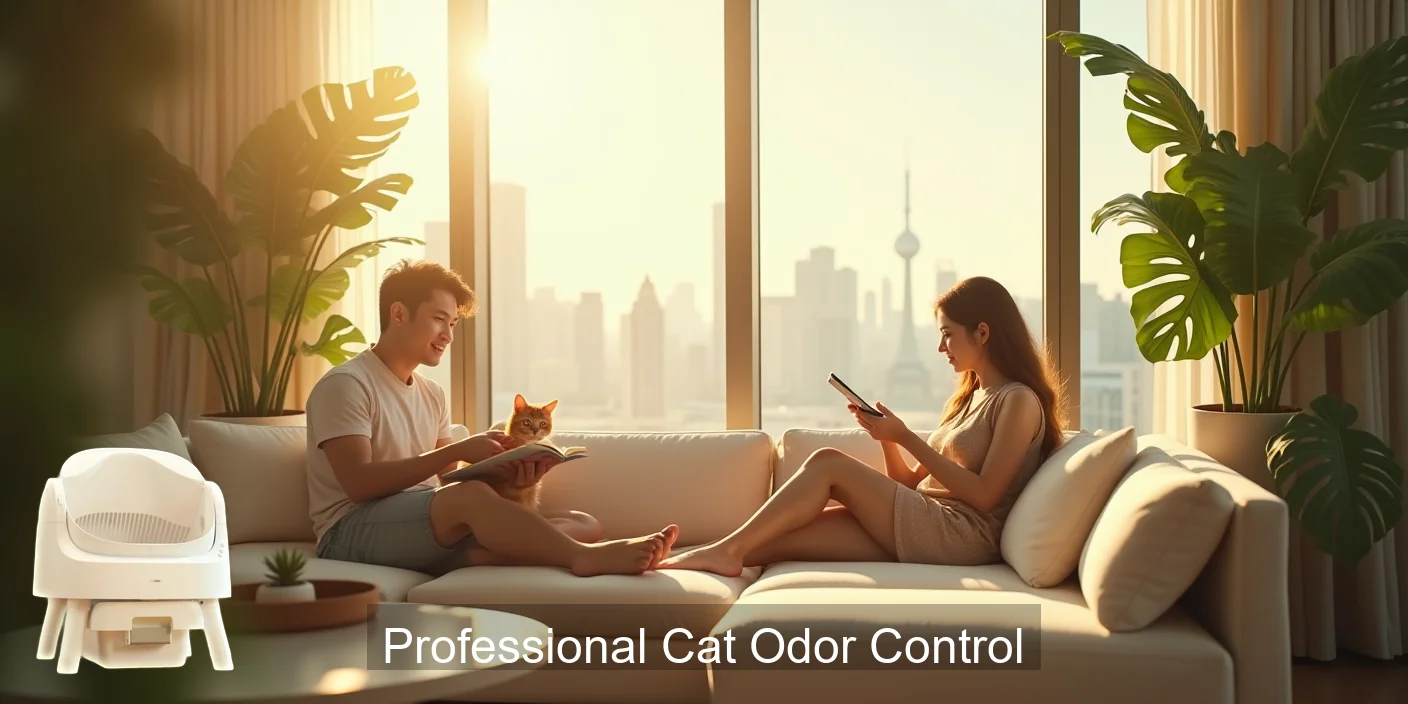Cat Odor Control: Eliminate Litterbox Smells & More

1. Understanding the Source of Cat Odors
Identifying the source of cat odors is the first step in effectively controlling them. While the litterbox is often the primary culprit, other factors can contribute to unpleasant smells. Understanding these sources allows you to target your cleaning and odor control efforts more effectively.
1.1 Litterbox Issues
The litterbox is the most common source of cat odors. Factors like the type of litter, frequency of cleaning, and the number of cats using the box all play a role in the intensity of the smell.
Odor Insights
- Choose a high-quality litter that effectively absorbs odors.
- Scoop the litterbox at least once a day, preferably twice.
- Completely empty and clean the litterbox at least once a month.
“A clean litterbox is a happy litterbox, and a happy litterbox means a happy home!” – Dr. Whiskers, Feline Odor Expert
FAQ: Litterbox Odors
Q: Why does my litterbox still smell even after cleaning?
Banishing Cat Urine Odor
1. **Eliminate stubborn cat urine odors.** Our powerful formula neutralizes smells at the source, leaving your home fresh and clean.
Conquer Cat Spray Smell
2. **Say goodbye to lingering cat smells.** Block 1 provides deep-cleaning action to remove odor-causing bacteria and leave behind a pleasant scent.
Eliminate Cat Odor Naturally
3. **Advanced odor control for cat messes.** This powerful block tackles even the toughest cat urine stains and odors, restoring freshness to your home.
Freshen Your Home Naturally
4. **More than just masking, true odor elimination.** Block 1 neutralizes cat odors instead of simply covering them up, offering long-lasting freshness.

Q: How often should I completely change the litter?
A: At least once a month, or more frequently if you have multiple cats.
Q: What’s the best type of litter for odor control?
A: Clumping clay litter, crystal litter, and natural litters like wood or paper are all good options. Experiment to find what works best for you and your cat.
Practical Advice: Place the litterbox in a well-ventilated area, but not in a high-traffic zone. Consider using a litterbox with a lid to help contain odors.
Statistic: Studies show that cats are more likely to use a clean litterbox, which reduces the chances of accidents outside the box and subsequent odor issues.
1.2 Other Sources of Cat Odors
Beyond the litterbox, other sources of cat odors include urine marking, hairballs, dental issues, and skin conditions.
- Neuter or spay your cat to reduce urine marking.
- Regularly groom your cat to minimize hairballs.
- Schedule regular dental checkups for your cat.
- Consult a vet if you notice any unusual skin odors or conditions.
“An ounce of prevention is worth a pound of cure, especially when it comes to cat odors!” – Anonymous Cat Lover
FAQ: Other Cat Odor Sources
Q: How can I tell if my cat is urine marking?
A: Urine marking is usually done on vertical surfaces and involves a small amount of urine. It often has a strong, pungent odor.
Q: What can I do about hairball odors?
A: Regular grooming and hairball remedies can help reduce hairball frequency and associated odors.
Q: My cat has bad breath. What should I do?
A: Schedule a dental checkup with your vet. Bad breath can be a sign of dental disease.
Practical Advice: Clean up accidents immediately with an enzymatic cleaner to neutralize the odor and prevent repeat offenses.

Statistic: According to the American Veterinary Dental College, 70% of cats show signs of dental disease by age 3, which can contribute to bad breath.
2. Effective Cleaning and Odor Removal Techniques
Once you’ve identified the source of the odor, it’s time to implement effective cleaning and odor removal techniques. This section covers various methods and products to help you eliminate cat odors from your home.
2.1 Enzymatic Cleaners
Enzymatic cleaners are specifically designed to break down the organic compounds that cause cat odors, such as urine, feces, and vomit. They are more effective than regular cleaners at completely eliminating the smell.
- Choose an enzymatic cleaner specifically designed for pet odors.
- Follow the instructions carefully, allowing the cleaner to soak into the affected area.
- Test the cleaner on an inconspicuous area first to ensure it doesn’t damage the surface.
“Enzymatic cleaners are a cat owner’s best friend when it comes to odor control!” – Happy Cat Home Blog
FAQ: Enzymatic Cleaners
Q: How do enzymatic cleaners work?
A: They contain enzymes that break down the organic compounds in urine, feces, and vomit, eliminating the odor at its source.
Q: Are enzymatic cleaners safe for my cat?
A: Yes, most enzymatic cleaners are formulated to be safe for pets, but always check the label.
Q: Can I use enzymatic cleaners on all surfaces?
A: Most enzymatic cleaners can be used on various surfaces, but it’s always best to test on an inconspicuous area first.
Practical Advice: Blot up as much of the stain as possible before applying the enzymatic cleaner. Allow the cleaner to air dry completely.
Statistic: A study by the Journal of Feline Medicine and Surgery found that enzymatic cleaners are significantly more effective at removing cat urine odors than regular household cleaners.
2.2 Other Cleaning Methods
In addition to enzymatic cleaners, other cleaning methods can help control cat odors, including regular vacuuming, steam cleaning, and using baking soda.
- Vacuum regularly, paying attention to areas where your cat spends the most time.
- Steam clean carpets and upholstery at least twice a year.
- Sprinkle baking soda on carpets and upholstery, let it sit for a few hours, and then vacuum it up.
“A clean home is a happy home, for both you and your cat!” – Martha Stewart (Probably)
FAQ: Other Cleaning Methods
Q: How often should I vacuum to control cat odors?
A: At least once a week, or more frequently if you have a shedding cat.
Q: Is steam cleaning safe for my carpets?
A: Yes, steam cleaning is generally safe for most carpets, but always check the manufacturer’s instructions.
Q: How long should I leave baking soda on carpets to absorb odors?
A: At least a few hours, or overnight for stubborn odors.
Practical Advice: Use a vacuum cleaner with a HEPA filter to trap allergens and odors more effectively.
Statistic: According to the Asthma and Allergy Foundation of America, regular vacuuming with a HEPA filter can significantly reduce allergens and odors in the home.

3. Choosing the Right Litter and Litterbox
The type of litter and litterbox you choose can significantly impact odor control. Selecting the right products can help minimize unpleasant smells and make litterbox maintenance easier.
Banishing Cat Urine Smell
1. **Eliminate lingering cat odors effectively.** Our powerful formulas neutralize unpleasant smells at the source, leaving your home fresh and clean.
Eliminating Cat Odor Naturally
2. **Banish cat urine and spray odors.** Block 2’s advanced enzyme technology breaks down odor-causing molecules, preventing future build-up.
Controlling Cat Spraying Odors
3. **More than just masking – true odor removal.** Say goodbye to temporary fixes. Block 2 tackles the root of the problem for long-lasting freshness.
Fresh Home, Happy Cat
4. **Safe and effective cat odor control for your home.** Our pet-safe formulas are tough on odors but gentle on your family and pets.
Your Pets Deserves This Litter Box!
3.1 Types of Litter
Various types of cat litter are available, each with its own advantages and disadvantages in terms of odor control, clumping ability, and dust levels.
- Experiment with different types of litter to find one that effectively controls odors and is acceptable to your cat.
- Consider using a litter with added odor-absorbing ingredients, such as baking soda or activated charcoal.
- Avoid litters with strong perfumes, as they can be irritating to cats and may not effectively mask odors.
“The right litter can make all the difference in controlling cat odors!” – Litterbox Guru
FAQ: Types of Litter
Q: What is the best type of litter for odor control?
A: Crystal litter is generally considered the best for odor control, but it can be more expensive. Clumping clay litter is a good alternative.
Q: Is clumping litter better than non-clumping litter for odor control?
A: Clumping litter makes it easier to remove urine and feces, which can help control odors. However, non-clumping litter can also be effective if changed frequently.
Q: Are natural litters like wood or paper effective for odor control?
A: Yes, natural litters can be effective for odor control, and they are also more environmentally friendly.
Practical Advice: Gradually transition your cat to a new type of litter by mixing it with their old litter over a period of several days.
Statistic: A survey of cat owners found that 60% prefer clumping litter for its ease of use and odor control.
3.2 Litterbox Design and Placement
The design and placement of the litterbox can also impact odor control. Choosing the right litterbox and placing it in an appropriate location can help minimize unpleasant smells.
- Consider using a covered litterbox to help contain odors.
- Explore self-cleaning litterboxes for automated maintenance.
- Place the litterbox in a well-ventilated area, away from food and water.
“Location, location, location! The right litterbox placement can make a big difference in odor control.” – Real Estate Agent for Cats
FAQ: Litterbox Design and Placement
Q: Are covered litterboxes better for odor control?
A: Yes, covered litterboxes can help contain odors, but they need to be cleaned regularly to prevent odor buildup inside the box.
Q: Do self-cleaning litterboxes really work?
Odor Metrics
A: Yes, self-cleaning litterboxes can be effective at reducing odors, but they can be expensive and may not be suitable for all cats.
Q: Where is the best place to put a litterbox?
A: In a well-ventilated area, away from food and water, and in a location that is easily accessible to your cat.
Practical Advice: If you have multiple cats, provide one litterbox per cat plus one extra.
Statistic: According to the American Association of Feline Practitioners, providing enough litterboxes is crucial for preventing litterbox avoidance and associated odor issues.
4. Addressing Underlying Health Issues
Sometimes, cat odors can be a sign of underlying health issues. Addressing these issues can not only improve your cat’s health but also help control unpleasant smells.

4.1 Urinary Tract Infections (UTIs)
UTIs can cause cats to urinate more frequently and with a stronger odor. If you suspect your cat has a UTI, consult a veterinarian.
- Monitor your cat for signs of a UTI, such as frequent urination or straining to urinate.
- Consult a veterinarian if you suspect your cat has a UTI.
- Follow your veterinarian’s recommendations for treatment, which may include antibiotics.
“A healthy cat is a happy cat, and a happy cat is less likely to have odor issues!” – Veterinarian’s Wisdom
FAQ: UTIs and Odor
Q: How can I tell if my cat has a UTI?
A: Look for symptoms such as frequent urination, straining to urinate, and blood in the urine.
Q: Can UTIs cause cat odors?
A: Yes, UTIs can cause cats to urinate more frequently and with a stronger odor.
Q: How are UTIs treated in cats?
A: UTIs are typically treated with antibiotics prescribed by a veterinarian.
Practical Advice: Ensure your cat has access to fresh water at all times to help prevent UTIs.
Statistic: According to the Cornell University College of Veterinary Medicine, UTIs are more common in female cats and older cats.
4.2 Dental Disease
Dental disease can cause bad breath in cats. Regular dental care can help prevent and treat dental disease, improving your cat’s breath and overall health.
- Brush your cat’s teeth regularly to prevent dental disease.
- Provide dental chews or toys to help clean your cat’s teeth.
- Schedule regular dental checkups with your veterinarian.
“Good dental hygiene is essential for a healthy and happy cat!” – Dental Health Advocate
FAQ: Dental Disease and Odor
Q: How can I tell if my cat has dental disease?
A: Look for symptoms such as bad breath, excessive drooling, and difficulty eating.
Q: Can dental disease cause bad breath in cats?
A: Yes, dental disease is a common cause of bad breath in cats.
Q: How can I prevent dental disease in my cat?
Banishing Cat Urine Odor
1. Banish stubborn cat odors with our powerful, enzyme-based cleaners. Safe for pets and effective on all surfaces.
Conquer Cat Spray Smell
2. Eliminate lingering cat smells at the source. Our block 3 solutions tackle urine, feces, and scratching post odors effectively.
Neutralize Cat Scents Naturally
3. Frustrated with lingering cat smells? Block 3 offers advanced odor neutralizers that break down odor molecules, not just mask them.
Eliminate Cat Odor Effectively
4. From litter box mishaps to accidental sprays, Block 3 provides the ultimate solution for complete cat odor control in your home.
A: Brush your cat’s teeth regularly, provide dental chews or toys, and schedule regular dental checkups with your veterinarian.
Practical Advice: Start brushing your cat’s teeth when they are young to get them used to the process.
Statistic: According to the American Veterinary Medical Association, dental disease is one of the most common health problems in cats.

Conclusion
Controlling cat odors is an ongoing process that requires a multi-faceted approach. By understanding the sources of odors, implementing effective cleaning techniques, choosing the right litter and litterbox, and addressing underlying health issues, you can create a fresh and inviting home for both you and your feline companion. Remember to regularly clean the litterbox, use enzymatic cleaners for accidents, and maintain good hygiene for your cat. Don’t hesitate to consult with your veterinarian if you suspect any underlying health issues contributing to unpleasant odors. With a little effort and dedication, you can enjoy the companionship of your cat without the worry of embarrassing odors. Ready to take control of cat odors in your home? Browse our selection of odor control products and start creating a fresher, cleaner environment today!


